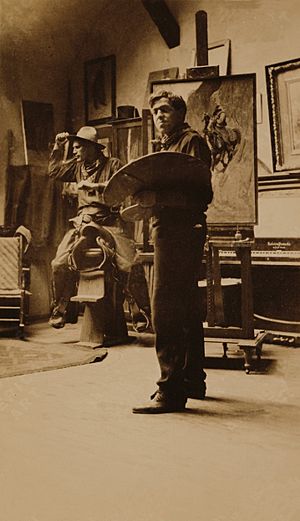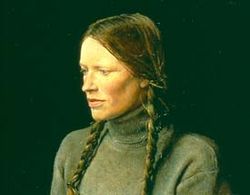Andrew Wyeth facts for kids
Quick facts for kids
Andrew Wyeth
|
|
|---|---|

Wyeth receiving the National Medal of Arts in 2007
|
|
| Born |
Andrew Newell Wyeth
July 12, 1917 |
| Died | January 16, 2009 (aged 91) Chadds Ford, Pennsylvania, U.S.
|
| Resting place | Hathorn Cemetery, Cushing, Maine, U.S. |
| Known for | Painting |
|
Notable work
|
Christina's World |
| Movement | Regionalist |
| Awards | Presidential Medal of Freedom |
Andrew Newell Wyeth (born July 12, 1917 – died January 16, 2009) was a famous American artist. He was mostly known for his realistic paintings, often called "realist" or "regionalist" art. He was one of the most well-known artists in the United States during the middle of the 20th century.
Wyeth loved to paint the places and people around him. He spent time in his hometown of Chadds Ford, Pennsylvania, and at his summer home in Cushing, Maine. He often said, "I paint my life." One of his most famous paintings is Christina's World, which he painted in 1948. This painting is now at the Museum of Modern Art in New York City.
Contents
Biography
Growing Up
Andrew was the youngest of five children. His father, N.C. Wyeth, was a famous illustrator and artist. His mother was Carolyn Bockius Wyeth. Andrew was born on July 12, 1917. This was exactly 100 years after the birth of Henry David Thoreau, a writer his father admired.
Andrew was taught at home because he was often sick. Like his father, he loved the poems of Robert Frost and the writings of Henry David Thoreau. These writers helped him feel a strong connection to nature. Movies and music also helped him develop his artistic feelings. He said the movie The Big Parade (1925) greatly influenced his work.
His father was Andrew's only art teacher. Andrew felt his father kept him in his own world, almost like a "jail." N.C. Wyeth was famous for illustrating books like Treasure Island. Their home was always busy with creative work. All five Wyeth children were talented artists or musicians.
His Father's Teaching
Andrew started drawing when he was very young. He could draw before he could even read. When he was a teenager, his father taught him art in his studio. His father helped him love rural landscapes and artistic traditions. Andrew even did some illustrations under his father's name when he was a teenager.
With his father's help, Andrew became very good at drawing figures and using watercolors. He later learned to paint with egg tempera from his brother-in-law, Peter Hurd. He also studied art history on his own. He admired many old masters and American painters, especially Winslow Homer.
N.C. Wyeth also taught Andrew to believe in his own artistic talents. He told Andrew not to worry about how others would receive his work. He believed a great artist needed deep emotions and passion. A great painting, he said, should broaden one's view of the world.
In October 1945, a sad event happened. Andrew's father and his three-year-old nephew died in a car accident. Their car was hit by a train. Andrew said his father's death was a very important moment for his art. Soon after, his painting style became more developed and lasting.
Family Life
On May 15, 1940, Andrew Wyeth married Betsy James. He met her in Maine in 1939. Betsy introduced him to Christina Olson, who later became the model for Christina's World. Betsy was very important in managing Andrew's art career. She once said, "I am a director and I had the greatest actor in the world."
Their first son, Nicholas, was born in 1943. Their second son, James ("Jamie"), was born three years later. Andrew painted portraits of both his children. His son Jamie Wyeth also became a painter, following in his father's and grandfather's footsteps. Andrew became a role model and teacher for Jamie, just as N.C. had been for him.
Later Years and Death
Andrew Wyeth passed away peacefully in his sleep on January 16, 2009. He was in Chadds Ford, Pennsylvania, and was 91 years old. His wife, Betsy, died later in 2020 at the age of 98.
His Artworks
In 1937, when Andrew was 20, he had his first art show in New York City. All his paintings sold out, and it was clear he would be a successful artist. His style was different from his father's. It was simpler, "drier," and used fewer colors. He believed that too much "picture-making" could be a danger in art.
Wyeth was a realist painter, like Winslow Homer. In a magazine article in 1965, Wyeth said he thought of himself as an "abstractionist." He explained that when you truly look at a simple object, you can find deep meaning. He felt his paintings had an "excitement that's definitely abstract."
He mostly painted in a regionalist style. This means he focused on the land and people around him. He painted scenes from his hometown in Pennsylvania and his summer home in Maine.
Wyeth painted in a realistic style for over 70 years. He often found inspiration during his solitary walks. He felt a deep connection to the land and sea. He wanted to show the history and unspoken feelings of these places. He would often make many sketches and watercolors before finishing a painting. He used watercolor, drybrush (a watercolor method with little water), or egg tempera.
Christina Olson and the Olson Farm
One of his most famous paintings, Christina's World (1948), was painted at the Olson farm in Cushing, Maine. The painting shows his neighbor, Christina Olson, lying in a dry field. She is looking at her house in the distance. Christina had a condition that made it hard for her to walk. She spent most of her time at home.
The Olson house has been kept and fixed up to look like it did in the painting. You can visit it as part of the Farnsworth Art Museum. Wyeth became good friends with Christina and her brother. He was allowed to explore their farm and house. He made almost 300 drawings, watercolors, and tempera paintings there. Some examples are Olson House (1939) and Wind from the Sea (1947).
Because of Wyeth's famous paintings, the Olson farm was named a National Historic Landmark in 2011.
Kuerner Farm
In the early 1930s, Wyeth started painting his neighbors in Chadds Ford, Anna and Karl Kuerner. The Kuerners and their farm were very important subjects for Wyeth for almost 50 years. As a teenager, Wyeth would walk the hills of the Kuerner Farm. He became close friends with Karl and Anna. They invited him into their home, and he painted them and their life.
Wyeth said about the Kuerner Farm, "It just excited me, purely abstractly and purely emotionally."
There was also a small community of African-Americans in Chadds Ford called "Little Africa." Andrew Wyeth painted Mother Archie's Church, a Quaker schoolhouse that became a church. He also painted African-American residents from this community.
You can tour the Kuerner Farm through the Brandywine River Museum. The farm was named a National Historic Landmark in 2011 because of its connection to Wyeth.
Helga Paintings
In 1986, people learned about a large collection of 247 studies by Wyeth. These were paintings and drawings of a German-born woman named Helga Testorf. Wyeth met Helga when she was caring for Karl Kuerner at his farm. Helga had never modeled before, but she became comfortable posing for long periods.
In these works, Helga is almost always shown without a smile and looking calm. But Wyeth still managed to show her personality and feelings. This large collection of studies of one person is very special in American art.
A publisher named Leonard E.B. Andrews bought almost all of these paintings in 1986. This kept the collection together. Wyeth had given a few Helga paintings to friends, including a famous one called Lovers, which he gave to his wife.
The Helga works were shown at the National Gallery of Art in 1987 and then toured across the country. There was a lot of discussion and different opinions about the exhibition. Some art critics did not like the show. The curator, Neil Harris, said it was "the most polarizing National Gallery exhibition of the late 1980s."
In a 2007 interview, Wyeth was asked if Helga would be at his 90th birthday party. He said, "Yeah, certainly. Oh, absolutely. She's part of the family now. I know it shocks everyone. That's what I love about it. It really shocks 'em."
Other Important Works
- Inspired by Winslow Homer, Wyeth painted an impressionistic watercolor called Coot Hunter around 1933. In this painting, he experimented with how light and movement change quickly.
- Public Sale (1943) is one of his first tempera paintings. It is at the Philadelphia Museum of Art.
- After his father's death, Wyeth's art became more serious. He painted Winter 1946 (1946). It shows a boy named Allan Lynch running down a bleak hill. This painting was made near where his father died. It showed the unsettling feeling of loss.
- Painted in 1947, Wind from the Sea shows a breeze coming through a window at the Olson house. It's a portrait without a person and was a favorite of the poet Robert Frost.
- Adam (1963) is a tempera painting of his neighbor, Adam Johnson.
- Brown Swiss (1957) is one of many paintings he made of Karl and Anna Kuerner's farm. It shows the farmhouse and its reflection in the pond.
- In 1958, Andrew and Betsy Wyeth bought and restored "The Mill." These 18th-century buildings often appeared in his art, like in Night Sleeper (1979).
- Garret Room (1962) is a painting of Wyeth's friend Tom Clark. It was started in watercolor and finished with the drybrush technique.
- Wyeth started painting more portraits in the 1960s, like Up in the Studio (1965), a drybrush portrait of his sister Carolyn.
- In works like The Patriot, a portrait of Ralph Cline, Wyeth tried to understand the person he was painting. Cline was an interesting man with Native American heritage. Wyeth learned that beneath his humor, Cline was a kind and smart veteran.
- Maidenhair (1974) is a tempera painting of a woman sitting in a church pew in Maine.
- Ring Road (1985) shows the earthy colors Wyeth often used.
- Raven's Grove (1985) is a great example of Wyeth's skill with egg tempera. He used precise marks to create depth and fine details.
How People Saw His Art
Andrew Wyeth's art has always caused discussion. He made beautiful paintings, had many fans, and became very wealthy. But art critics and historians had different ideas about how important his work was. One art historian, Robert Rosenblum, once named Andrew Wyeth as both the "most overrated and underrated" artist of the 20th century.
People who admired Wyeth's art believed his paintings were not only beautiful but also had strong emotions and hidden meanings. Most people agree he was very skilled with egg tempera (which uses egg yolk) and watercolor. He did not use oil paints. His use of light and shadow made his subjects shine. His paintings often suggested sounds, like in Distant Thunder (1961). Christina's World became a very famous image, known by millions.
Wyeth's work was very different from abstract art, which was popular in American art during the mid-20th century.
His art shows have attracted many visitors to museums. However, some art critics did not like his work as much. Some felt his rural subjects were boring or too sweet.
Wyeth's father taught him to paint from his own feelings and ideas. He believed artists should fully explore their abilities.
Where to See His Art
You can find Andrew Wyeth's work in many major American museums. These include the Museum of Modern Art in New York City, the National Gallery of Art, and the Metropolitan Museum of Art. President George W. Bush and Laura Bush even decorated a room in the White House with Wyeth paintings.
There are especially large collections at the Brandywine River Museum in Pennsylvania, the Farnsworth Art Museum in Maine, and the Greenville County Museum of Art in South Carolina.
His paintings are also in museums around the world. These include the National Museum of Modern Art in Tokyo and the Hermitage Museum in St. Petersburg.
Awards and Honors
Andrew Wyeth received many important honors and awards:
- 2007: The National Medal of Arts
- 1988: The Congressional Gold Medal, the highest honor given by the U.S. government to a civilian
- 1980: He was the first living American artist to be chosen for Britain's Royal Academy
- 1977: He was the first American artist since John Singer Sargent to be chosen for the French Académie des Beaux-Arts
- 1963: He was the first painter to receive the Presidential Medal of Freedom
- 1947: He won the gold medal for painting from the American Academy of Arts and Letters
He also received many honorary degrees from universities.
See Also
 In Spanish: Andrew Wyeth para niños
In Spanish: Andrew Wyeth para niños
- Wyeth




